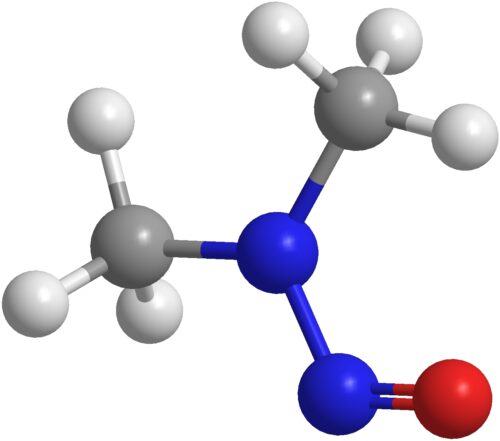This is the second in a series of entries examining nitrosamines in a range of products. Our first article presented an overview of nitrosamines, including a historical look at their implication as probable carcinogens. This entry will review their presence in active pharmaceutical ingredients (APIs) and process mitigation strategies.
Nitrosamines are organic compounds found in medications, the human diet, and the environment These carcinogens can cause tumors in nearly all organs and have been classified as possible genotoxic impurities (GTI).
Background on Nitrosamines in Active Pharmaceutical Ingredients
The linkage between cancer and a large class of chemical compounds known as nitrosamines was postulated by William Lijinsky in 1970.1 Then, in June 2018, their presence (specifically, N-nitroso-dimethylamine (NDMA)) was detected in the API Valsartan, an Angiotensin-II-receptor antagonist.
 NDMA
NDMA
It later became “obvious that the issue may not only occur with sartans but, in principle, with any API containing a vulnerable amine and a nitrosation source. Hence not only NDMA but a plethora of potential nitrosamines could be created.”2 They have been subsequently detected in other medicines resulting in 250 product recalls, affecting more than 1400 lots.3,4 The cost of recalls could be high.5 APIs or their impurities can become nitrosated “during the later stages of the synthetic process of the drug product manufacturing or even while in the completed, packaged product.”6 As discussed in our previous entry, primary amines are not a concern, as they have limited stability.6 However, secondary and tertiary amines, along with quaternary ammonium compounds, are considered potential nitrosamine precursors, according to the current guidelines of the FDA and EMA.6,7 As a useful reference for amine components, there is a central system for the ingredients in medicinal products known as the Global Substance Registration System (GSRS https://gsrs.ncats.nih.gov/.)8 Some of the possible causes for the presence of nitrosamines are:
- The use of sodium nitrite (NaNO2), or other nitrosating agents.
- The use of raw materials and intermediates contaminated by nitrosamines
- Degradation processes of starting materials, intermediates, and drug substances during formulation or storage
- The use of certain contaminated packaging materials
Detection Tools
Fortunately, there are many tools to detect nitrosamines. NDMA, NDEA, and other nitrosamine impurities can be detected at ppb level using gas chromatography, such as with a QTOF (Quadrupole Time of Flight Mass Spectrometer) or triple quadrupole.
Ways to Mitigate Nitrosamine Formation
There are numerous ways that nitrosamines can be mitigated through API process design. For example, the FDA’s Control of Nitrosamine Impurities in Human Drugs Guidance for Industry, issued by the Center for Drug Evaluation and Research, states that: “The following factors should be considered during process development:
- Avoiding reaction conditions that may produce nitrosamines whenever possible; when not possible, demonstrating that the process is adequately controlled and is capable of consistently reducing nitrosamine impurities through appropriate and robust fate and purge studies.
- Using bases other than secondary, tertiary, or quaternary amines (when possible) if ROS (Route of Synthesis) conditions may form nitrosamines
- Using caution when the ROS involves the use of amide solvents (e.g., N,N-dimethylformamide, N,N-dimethylacetamide, and N-methylpyrrolidone)
- Replacing nitrites with other quenching agents for azide decomposition processes.
- Optimizing and consistently controlling the sequences of reactions, processes, and reaction conditions (such as pH, temperature, and reaction time)
- Designing a manufacturing process that facilitates the purge of nitrosamine impurities in the subsequent processing steps.
- Auditing API supply chains accompanied by continuous monitoring for any at-risk raw materials, starting materials and intermediates, and avoiding cross-contamination when using recovered materials such as solvents, reagents, and catalysts in the manufacturing process.
- Recovered material should be used only in the same step or in an earlier step. API manufacturers should be aware that potable water used in API manufacture may contain low levels of nitrite and even nitrosamines from environmental contamination”.9,10
Solutions
Nitrosamines are an inevitable chemical outcome in the manufacturing and processing of many items, including APIs. Due to their low concentrations, they are also challenging to detect. AMPAC Analytical has rigorous testing services available to screen to trace levels in challenging sample matrices, including process intermediates, drug substances, and drug products. We have the specialized expertise, equipment, and methodologies to detect these impurities by gas chromatography or high-performance liquid chromatography coupled with mass spectrometry. Please contact us with any specific questions or to receive a quote for nitrosamines screening.
References
- https://doi.org/10.1038/225021a0
- https://jpharmsci.org/article/S0022-3549(23)00018-7/fulltext
- https://doi.org/10.1021/acs.jmedchem.0c02120
- https://doi.org/10.1016/j.xphs.2022.11.013
- https://www.bloomberg.com/news/articles/2022-09-01/drug-recalls-for-nitrosamines-could-cost-big-pharma-millions
- https://www.fda.gov/media/141720/download
- https://www.ema.europa.eu/en/documents/referral/nitrosamines-emea-h-a53-1490-assessment-report_en.pdf https://doi.org/10.1093/nar/gkaa962
- https://doi.org/10.1093/nar/gkaa962
- https://ampacanalytical.com/wp-content/uploads/2023/01/Control-of-Nitrosamine-Impurities-in-Human-Drugs-Guidance-for-Industry.pdf
- https://www.who.int/water_sanitation_health/water-quality/guidelines/en/
Resources & Further Reading
AMPAC
- Watch Our On-Demand Webinar on Genotoxic Impurities
https://ampacanalytical.com/events/on-demand-webinar/
- AMPAC Analytical’s Nitrosamine Impurities Testing Webpage
https://ampacanalytical.com/laboratory-services/ampac-analytical-offers-ndma-analyses-of-api-and-dp/#1644962917933-ed2cb310-b026
General Information on Nitrosamines
- An Organic Chemist’s Guide to Nitrosamines: Their Structure, Reactivity, and Role as Contaminants
https://pubs.acs.org/doi/10.1021/acs.joc.0c02774?ref=pdf
Nitrosamine and Pharmaceuticals
- Information about Nitrosamine Impurities in Medications
https://www.fda.gov/drugs/drug-safety-and-availability/information-about-nitrosamine-impurities-medications - Prevalence of Nitrosamine Contaminants in Drug Samples: Has the Crisis Been Overcome?
https://doi.org/10.1002/ardp.202200484 - Nitrosamines Impurities in Pharmaceuticals, the Abrupt Challenges They Bring, and Approaches to Tackle the Risk
https://doi.org/10.1016/j.xphs.2022.07.016 - Critical Analysis of Drug Product Recalls Due to Nitrosamine Impurities
https://doi.org/10.1021/acs.jmedchem.0c02120 - Estimated Cancer Risks Associated with Nitrosamine Contamination in Commonly Used Medications
https://doi.org/10.3390/ijerph18189465 - Regulatory Experiences with Root Causes and Risk Factors for Nitrosamine Impurities in Pharmaceuticals
https://doi.org/10.1016/j.xphs.2022.12.022 - FDA: Information about Nitrosamine Impurities in Medications
https://www.fda.gov/drugs/drug-safety-and-availability/information-about-nitrosamine-impurities-medications

